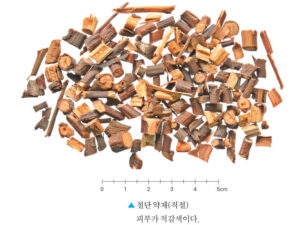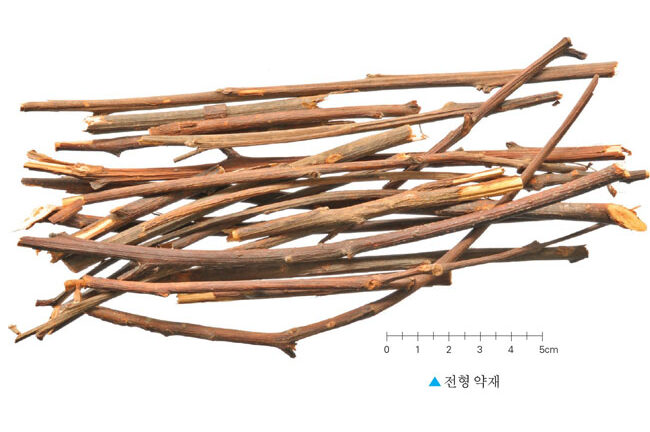Herbal Medicine: Cinnamomi Ramulus
| Herb | Cinnamomi Ramulus |
|---|---|
| Latin name | Cinnamomi Ramulus |
| Scientific name | Cinnamomum cassia Presl |
| Origin | Young branches of the Cinnamomum cassia Presl tree |
| Properties | Spicy, sweet and warm |
| Channels Targeted | Heart (心), Lungs (肺), and Bladder (膀胱) meridians |
| Efficacy | 發汗解肌, 溫經通陽,助陽化氣 |
| Administration | Early cold, hyperhidrosis, abdominal pain, edema, palpitations, sensitivity to cold |
| Dosage | 4~12g |
| Suitable Constitution | lesser yin(So-eum) person(소음인) |
| Unsuitable Constitution | lesser yang(So-Yang) person(소양인) |


Origin
Differences Between Cinnamomi Ramulus, Cinnamon, and Their Variants
Cinnamomi Ramulus originates from the young branches of the Cinnamomum cassia Presl tree.
- Korean cinnamon refers to the bark of the stem of the cassia tree, excluding the deeper layers of the stem.
- And it’s commonly used in Korean cuisine for its flavor.
- The term “cassia” denotes a thicker bark obtained from the cinnamon tree, considered to have a heavier nature and is primarily used for medicinal purposes.
- However, Cinnamomi Ramulus, is made from the young branches of the cassia tree and utilizes the whole branch.
- Western cuisine employs Cinnamon (as known globally) derived from the bark of different species of trees.
- Compared to cassia, it has a milder spicy taste and aroma, making it a popular spice in various dishes.
Properties
It is spicy, sweet (辛甘), and warm (溫).
Channels Targeted
It acts on the Heart (心), Lungs (肺), and Bladder (膀胱) meridians.
Indications and Effects
It can be used to treat early-stage colds accompanied by fever and sweat, abdominal pain, edema, palpitations, and cold sensations by warming and promoting circulation.
Efficacy
- 해기(解肌): a general term for dispelling pathogens from the superficial flesh
- 온경(溫經): a therapeutic method of warming and unblocking the meridian/channel
- 통양(通陽): a therapeutic method used to address blockage of yang qi due to cold-damp obstruction or congealing phlegm and stasis obstruction
Recommended Dosage
- The typical dosage ranges from 4 to 12 grams, brewed into tea for consumption.
- As the branches do not infuse easily, it is advised to soak them in water for 30 minutes to an hour before boiling for about 30 to 60 minutes to extract their properties effectively.
- Herbs with light flavors should be boiled for about 30 to 60 minutes to maximize their effects, whereas heavier ones like cassia bark may require boiling for 1.5 to 2 hours for optimal results.
Side Effects and Safety Rating
Cinnamomi Ramulus is considered a light and relatively non-toxic herb.
Principles and Clinical Experience
- Being a part of the cassia tree, Cinnamomi Ramulus possesses a warm, spicy, and sweet flavor.
- However, since the central part of the branch is not removed and due to its young age, its spicy and sweet taste is milder compared to cassia, and its nature is lighter, affecting the outer and superficial parts of the body, thereby aiding in the circulation of Qi in the Heart, Lungs, and Bladder.
- Cinnamomi Ramulus is a key ingredient in Guizhi Tang(계지탕), a well-known herbal formula. It directs its spicy properties to the Kidneys and Bladder, properly guiding the bladder’s fluids to the skin to induce appropriate sweating and treat colds.
- Guizhi and Guizhi Tang have a unique approach compared to standard fever reducers and painkillers; they encourage our body to produce the right amount of heat and sweat.
- This action not only boosts our immune system but also helps us quickly overcome infections, establishing them as potentially ideal treatments for infectious diseases.
- For infections like Covid-19, whose causes may not be fully understood, Guizhi and Guizhi Tang can still offer benefits.
- They work by enhancing the body’s immune system, rather than targeting the pathogens directly, making them potentially effective against unknown viruses and bacteria.
- It’s unfortunate, though, that despite their benefits, natural remedies like Guizhi and Guizhi Tang are not readily available in pharmacies, limiting their widespread use.
- Another notable formula is Guizhi Fuling Wan(계지복령환), which is used when the Kidneys and Womb are cold, leading to stagnant blood flow.
Suitable and Unsuitable Constitutions
Its warm, spicy, and sweet nature benefits those with lesser yin(So-eum) person(소음인).
References
- KMCRIC 생약 up-to-date
- KIOM 본초감별도감 (사진)
- [본초학] 전국한의과대학 본초학공동교재편찬위원회
- [한의학대사전] 한의학대사전 편찬위원회
- [새로 쓴 사상의학] 유주열
- [동의보감]
- [본초비요 本草備要]
Disclaimers
The content provided here is for educational purposes and should not substitute for medical advice from a healthcare professional. Always seek the guidance of a medical professional for medical treatments.


